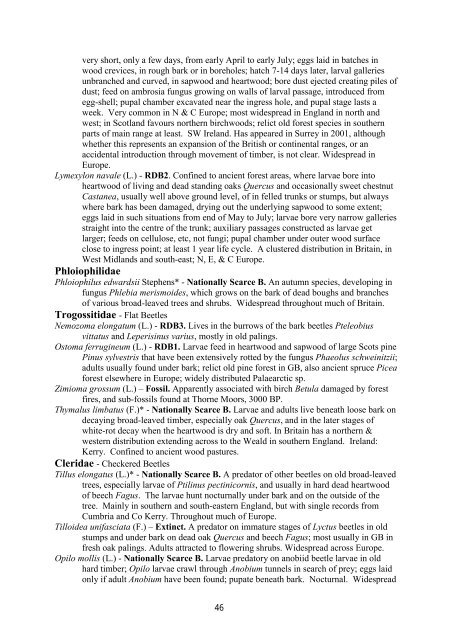Crustacea: Copepoda - Cerambycoidea.com
Crustacea: Copepoda - Cerambycoidea.com
Crustacea: Copepoda - Cerambycoidea.com
Create successful ePaper yourself
Turn your PDF publications into a flip-book with our unique Google optimized e-Paper software.
very short, only a few days, from early April to early July; eggs laid in batches in<br />
wood crevices, in rough bark or in boreholes; hatch 7-14 days later, larval galleries<br />
unbranched and curved, in sapwood and heartwood; bore dust ejected creating piles of<br />
dust; feed on ambrosia fungus growing on walls of larval passage, introduced from<br />
egg-shell; pupal chamber excavated near the ingress hole, and pupal stage lasts a<br />
week. Very <strong>com</strong>mon in N & C Europe; most widespread in England in north and<br />
west; in Scotland favours northern birchwoods; relict old forest species in southern<br />
parts of main range at least. SW Ireland. Has appeared in Surrey in 2001, although<br />
whether this represents an expansion of the British or continental ranges, or an<br />
accidental introduction through movement of timber, is not clear. Widespread in<br />
Europe.<br />
Lymexylon navale (L.) - RDB2. Confined to ancient forest areas, where larvae bore into<br />
heartwood of living and dead standing oaks Quercus and occasionally sweet chestnut<br />
Castanea, usually well above ground level, of in felled trunks or stumps, but always<br />
where bark has been damaged, drying out the underlying sapwood to some extent;<br />
eggs laid in such situations from end of May to July; larvae bore very narrow galleries<br />
straight into the centre of the trunk; auxiliary passages constructed as larvae get<br />
larger; feeds on cellulose, etc, not fungi; pupal chamber under outer wood surface<br />
close to ingress point; at least 1 year life cycle. A clustered distribution in Britain, in<br />
West Midlands and south-east; N, E, & C Europe.<br />
Phloiophilidae<br />
Phloiophilus edwardsii Stephens* - Nationally Scarce B. An autumn species, developing in<br />
fungus Phlebia merismoides, which grows on the bark of dead boughs and branches<br />
of various broad-leaved trees and shrubs. Widespread throughout much of Britain.<br />
Trogossitidae - Flat Beetles<br />
Nemozoma elongatum (L.) - RDB3. Lives in the burrows of the bark beetles Pteleobius<br />
vittatus and Leperisinus varius, mostly in old palings.<br />
Ostoma ferrugineum (L.) - RDB1. Larvae feed in heartwood and sapwood of large Scots pine<br />
Pinus sylvestris that have been extensively rotted by the fungus Phaeolus schweinitzii;<br />
adults usually found under bark; relict old pine forest in GB, also ancient spruce Picea<br />
forest elsewhere in Europe; widely distributed Palaearctic sp.<br />
Zimioma grossum (L.) – Fossil. Apparently associated with birch Betula damaged by forest<br />
fires, and sub-fossils found at Thorne Moors, 3000 BP.<br />
Thymalus limbatus (F.)* - Nationally Scarce B. Larvae and adults live beneath loose bark on<br />
decaying broad-leaved timber, especially oak Quercus, and in the later stages of<br />
white-rot decay when the heartwood is dry and soft. In Britain has a northern &<br />
western distribution extending across to the Weald in southern England. Ireland:<br />
Kerry. Confined to ancient wood pastures.<br />
Cleridae - Checkered Beetles<br />
Tillus elongatus (L.)* - Nationally Scarce B. A predator of other beetles on old broad-leaved<br />
trees, especially larvae of Ptilinus pectinicornis, and usually in hard dead heartwood<br />
of beech Fagus. The larvae hunt nocturnally under bark and on the outside of the<br />
tree. Mainly in southern and south-eastern England, but with single records from<br />
Cumbria and Co Kerry. Throughout much of Europe.<br />
Tilloidea unifasciata (F.) – Extinct. A predator on immature stages of Lyctus beetles in old<br />
stumps and under bark on dead oak Quercus and beech Fagus; most usually in GB in<br />
fresh oak palings. Adults attracted to flowering shrubs. Widespread across Europe.<br />
Opilo mollis (L.) - Nationally Scarce B. Larvae predatory on anobiid beetle larvae in old<br />
hard timber; Opilo larvae crawl through Anobium tunnels in search of prey; eggs laid<br />
only if adult Anobium have been found; pupate beneath bark. Nocturnal. Widespread<br />
46

















